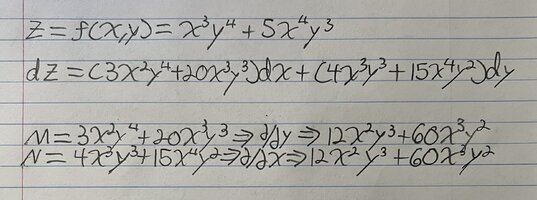Integrate
Junior Member
- Joined
- May 17, 2018
- Messages
- 129
I understand that (∂F/∂x)dx+(∂F/∂y)dy=0 is the derivative of a function set to a constant. My calc 3 is rusty so I forget how this general form is created but not the topic of this post.
I understand that if M=∂F/∂x and then ∂M/∂y=(∂^2 F/∂y)∂x and (∂^2 F/∂x)∂y = ∂N/∂x
I also understand that fₓᵧ = fᵧₓ which is how this statement is true.
I just don't know how we get from
if M=∂F/∂x and then ∂M/∂y=(∂^2 F/∂y)∂x and (∂^2 F/∂x)∂y = ∂N/∂x
What are the steps inbetween or context that makes this true?
I want to understand not memorize.
I understand that if M=∂F/∂x and then ∂M/∂y=(∂^2 F/∂y)∂x and (∂^2 F/∂x)∂y = ∂N/∂x
I also understand that fₓᵧ = fᵧₓ which is how this statement is true.
I just don't know how we get from
if M=∂F/∂x and then ∂M/∂y=(∂^2 F/∂y)∂x and (∂^2 F/∂x)∂y = ∂N/∂x
What are the steps inbetween or context that makes this true?
I want to understand not memorize.

